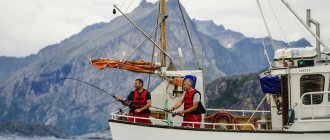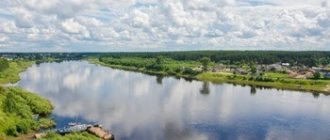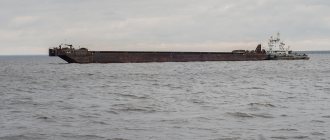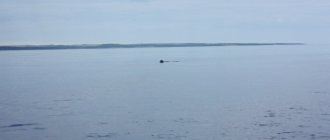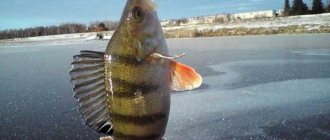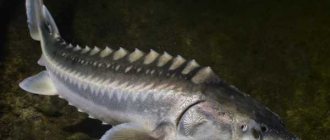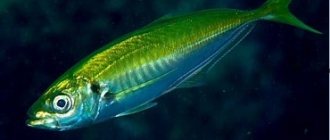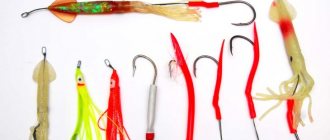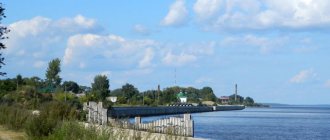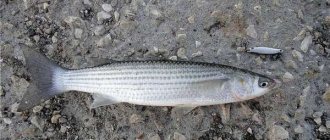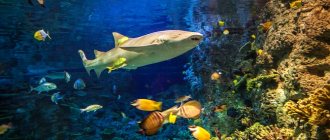The White Sea, being a vast bay of the Arctic Ocean, is quite cold. Nevertheless, the skerries and sea expanses, as well as the amazing taiga nature, attract many. People come here for privacy from the hustle and bustle of cities. Relaxation, fishing on the White Sea, fish soup cooked over a fire right on the shore - what could be better for relaxing and gaining strength.
Interesting information
This vast bay of the Arctic Ocean is famous for its fairly cold water. And this is not surprising, because it is enough to imagine where the White Sea is located: it is located in the very north-west of Russia. And only due to the fact that it is deeply cut into the mainland, its water sometimes manages to warm up to eighteen degrees in a short summer period.
Since the White Sea is surrounded by land on almost all sides, it is considered inland. The bottom of this relatively small salty reservoir is characterized by a very complex topography. The Kandalaksha Bay is considered its deepest part.
A huge amount of fresh water constantly flows into the White Sea. As a result, its level rises, and the excess mass of water along the Gorlo, connecting it to the Barents Sea, flows away. This water exchange is very favorably influenced by frequent south-west winds. The ebb and flow of the white sea is clearly pronounced. As a result of their complex interaction, a standing wave is formed in this relatively small inland body of water.
Best time to relax
The presence of the Arctic Circle nearby explains why it is cold here in the spring, sometimes with frosts. Therefore, the best time to go on vacation and fishing to the White Sea is considered to be July or early August. During this season, the water is as warm as possible, it warms up to eighteen degrees. You can even swim, although sometimes the weather brings surprises: it can suddenly become stormy, and strong winds often begin.
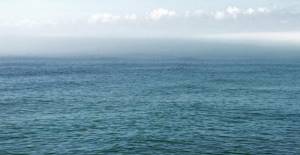
The most convenient places for those who come not only to fish on the White Sea, but also to relax, are Nikolskaya Bay near the village of Nizhnyaya Pulonga, as well as the village of Chkalov.
Small Karelian villages in which guest houses are built, the presence of shops, asphalt roads - all this attracts lovers of a calm, measured pastime, those who want not only to relax, but also go fishing. People primarily come to the White Sea for cod, although herring and salmon are also desirable prey.
In the sea, the tidal current changes to ebb twice a day. The height of the waves on average does not exceed two or three meters, and only in places close to the exit to the Barents Sea are they sometimes twice as high. The most favorable time for sport fishing is considered to be from mid-high tide to mid-low tide. At this time, the fish especially intensively approaches the shoreline and most often gets hooked.
Rest
There are no equipped anchorages (except for the Solovetsky Islands) on the White Sea.
Camping
There are several convenient free sites with a frame for equipping a tourist bath, a stream with drinking water and a beautiful view:
- Izbnaya Luda . Located at coordinates 65.9037,34.7602.
- Cocoiha Island . Located at coordinates 66.4867706,33.4692535.
- The shore of Onega Bay . Coordinates 64.8107750000,34.936447.
- Izba on Kislukha. Can be found at coordinates 65.2403388889,34.5732666667.
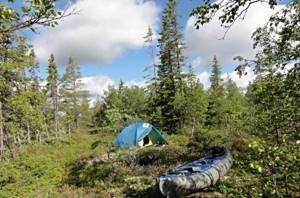
- In front of Cape Kamenny. 65.5754583333,34.7865305556.
Tent camp on Solovki is paid (300 rubles). But it is fully equipped with a shower (200 rubles), a toilet, tables and even a bathhouse (3000 rubles).
Fishing
There is a high tide twice a day, reaching 7 m in the area where the Barents Sea exits. The best time for fishing is during the first low tide, when the fish swim to the shore in schools.
It is distributed unevenly: there are no marine inhabitants in the Onega, Mezen and the most fresh Dvina Bays. But in Kandalaksha Bay and near the northern shores you can even see pink salmon. You can fish on the White Sea at all times of the year.
Several popular options:
- Embankment of the Northern Dvina within Arkhangelsk . Here you can find perches, ruffs, pikes and whitefish (the latter can only be caught by experienced fishermen).
- Forest lakes Smerde and Izhmozero are rich in bream, perch and roach. Even on a cold winter day there is no strong wind here.
- Solovetsky Islands. A catch here is guaranteed for everyone, even beginners. You can fish both on the lakes of the islands and by going out to sea on a boat rented from hotels. Descriptions of the types of fish that can be caught on a particular island (and there are 500 of them) hang in crowded places. Attention: 5 km of water area and the islands themselves are a specially protected area.
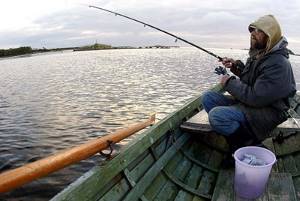
4 interesting bases with fishing:
- "Shore". The fishing and hunting base in the Valashinsky district offers fishing for bream, burbot, asp, perch and pike perch. Additionally, you can hunt game or go pick mushrooms and berries. You can stay in comfortable houses (each with 3 double rooms). Additional services: bathhouse, summer kitchen, dining room, relaxation room. Price: 500 rub./person; tel. +7 (921) 827 29 47.
- "House-bath". Located in the village of Poyakonda on a private island. 6 people can stay, so it’s better to go with a group. The first floor of the house is occupied by a small kitchen, a living room and a small wood-burning sauna with a stove. On the second floor there are two bedrooms with a beautiful view of the sea and a dry closet. Anglers prefer ice fishing for smelt. They also catch flounder, perch, catfish and lumpfish. Price: 800 rub./person; tel..
- "Pulonga". This recreation center is located 100 meters from the White Sea in the village of Nizhnyaya Pulonga. 23 people can fit. Organized meals - dishes of Karelian and Russian cuisines. All food is prepared using spring water. There is a store a few steps away. They organize a variety of fishing trips: to Lake Verkhnee Pulonskoe; to the Chupinskaya Bay of the White Sea; to Kishkin Island. In each case, an instructor, a boat, life jackets, and fishing equipment are included. Services also include: a bathhouse on the seashore, various board games, walks through the local forest. Price: 2000 rub./person; tel..
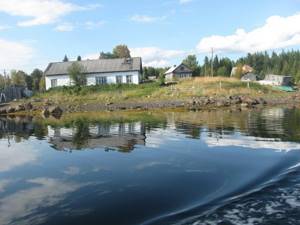
You can spend your holiday on the White Sea in the village of Nizhnyaya Pulonga. The fishing there is excellent. - Nereis. In the Chkalovsky village on Guba Chuba you can book a room at the dive center. The first level of the building is occupied by service rooms, a relaxation room, a sauna and a comfortable toilet with a bathtub. The second floor consists of 11 double rooms and 3 shower rooms. The third is the common room, dining room and promenade deck. The base organizes not only river and sea fishing, but also diving: breakfast at the hotel, dives, lunch on the islands, dinner at the hotel. Catch: trout, pike, flounder, bream, perch, and many other species. Guide services are offered. Additionally, holidays are organized. Price: 3000 rub./person; tel. +.
Alloy
Options:
- Along the Keret River. It flows through the harsh and attractive region of North Karelia. Tours along the Keret River give you the opportunity to get acquainted with the unique nature of the region and the real romance of taiga camps. Tourists will be able to go fishing, spend the night on Krivoe Island, and have a tourist bathhouse. Access to the White Sea near the village of Nizhnyaya Pulonga. The evening transfer to Chupy station awaits you there. Price: 5 participants – 17,000 rub./person, 3 participants – 21,000 rub./person. The price includes: service, instructor, equipment rental and three meals a day. Additionally, you can pay for train tickets and souvenirs.
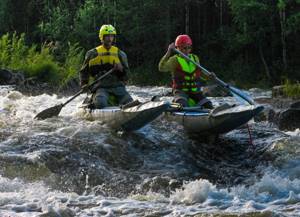
- Along the Syuzma River. Holidays on the White Sea are great for those who like river rafting. Rafting on this river is possible only in the spring, when it is full of water, because in the summer Syuzma looks like a small stream. The tour takes 3 days: two-day rafting with an overnight stay, fishing in the estuary area, a four-hour passage across the White Sea. The ancient village of Pomors has no electricity and is practically deserted, so no one will stop tourists from enjoying the harsh northern nature. You can catch pike, cod, catfish, nova and perch. All caught fish can be easily cooked on a fire or in the equipped kitchen of a mini-hotel. Price: for 5 people – 11,000 rubles. It includes accommodation in a comfortable house with a shower and a warm toilet; rental of yacht and tourist equipment. Meals for an additional fee.
- Along the Umba River. The tour takes 9 days. The journey begins from Apativy station. There, tourists will be transferred to the Umba River, given instructions and rafting to the interesting kilometer-long Padun rapids (the river is divided in half by a rocky island: the narrow left channel is a powerful 1 m waterfall with a foamy discharge, the right one has a drop of 2 m, a length of 10 m). The threshold is the highlight of the whole trip. There is also a field bathhouse for tourists. The tour includes the islands of Lake Kozero with unique rock paintings of ancient people, which became famous in 1997. The end of the trip is expected in the Pomeranian fishing village of Umba, where tourists can go fishing and see historical Pomeranian buildings.
5 participants – 12,000 rub. The price includes: transfer, meals, rental of equipment for tourists and rafting, insurance.
Winter holidays
If a tourist comes to the winter White Sea for the first time, then he is recommended to take a 3-day tour “260 km of snowmobile happiness”. What awaits him: a trip to the ice waterfall, the adits of the Garnet Warrack, Cape Kartesh, the shore of the White Sea and the crossing of the Arctic Circle. The route runs along a forest road, a frozen lake, and taiga. The cost of the tour is 36,600 rubles. per person.
Includes:
- accommodation in a double room in a cozy cottage;
- good nutrition;
- Instructor;
- snowmobile lesson;
- service;
- equipment rental;
- transfer.

Additionally paid: sauna session (1500 rubles/hour - during the day and 2000 rubles/hour - at night, minimum order for 2 hours), souvenirs, train tickets. Those who want a longer trip are offered a tour through the snowy taiga “On the way to the north”.
Tourists will visit Paanajärvi Park, Khibiny Mountains, Snow Village, and the city of Kirovsk - the capital of Russian Lapland. Price – 30,000 rub./person. "Christmas on the White Sea" for the whole family. 7 day tour. Educational master classes and quizzes are organized for children.
Tourists can expect:
- biological excursion “White Sea”;
- master classes on seaweed dishes, Pomeranian liqueurs, igloo construction;
- tourists will be able to learn about Pomeranian culture;
- getting to know the tracks of local wild animals (for children), making cosmetics, snowmobiling (for parents);
- reconstructed Pomeranian salt laboratory;
- ice fishing.
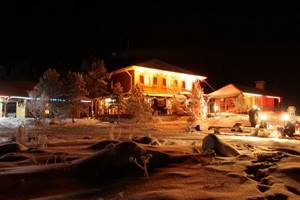
Tour cost (accommodation in a standard room): 46,000 rubles. per person.
Flora and fauna
In this sea they are much poorer than, for example, in the neighboring Barents Sea. For comparison: in the latter, on one hectare of water, you can catch almost five times more fish than in Bely. Experts explain this by the fact that the climatic conditions here are more severe, besides, the salt content in the water is lower, and the winter is too harsh. And if boreal forms from the animal and plant worlds live closer to the surface, then at a depth below fifty meters, where the same temperature is constantly maintained, arctic ones are already found. Cold-water relics are widely represented in this zone.
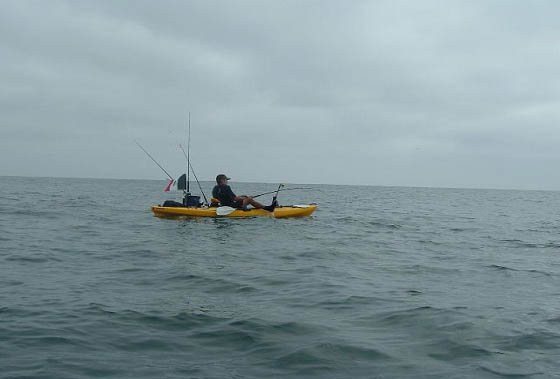
Of all the varieties of fish in the White Sea, fishing is carried out primarily for herring, cod, salmon, pollock, flounder and navaga. Their main habitats are coastal zones with a maximum depth of up to thirty meters - places where hunting for them is especially favorable.
Fishing places
In terms of its depth differences, bottom relief and varying salt concentrations, the White Sea is heterogeneous. And therefore the distribution of fish in it is also unequal. The number of not only marine animals, but also plants is sharply reduced in highly desalinated bays, such as Dvinsky, Mezensky and Onega. There are no typical representatives of marine fish here - pollock, cod, catfish, haddock, etc. But Kandalaksha Bay, as well as the northern coast of the White Sea, where the water is saltier, are excellent places where you can catch a lot of saltwater prey. Another fishing place is the Karelian Isthmus, which is visited by many spearfishing enthusiasts. This, according to many, is one of the most peaceful and beautiful places not only in the region, but throughout Russia, where there is an abundance of fish and freedom for hunters. The most desirable prey for true lovers of spearfishing are sea salmon or brown trout, which are excellently caught all summer with both spinning and fly fishing gear, as well as pink salmon. The latter has been found since mid-July in places where rivers flow into the White Sea.
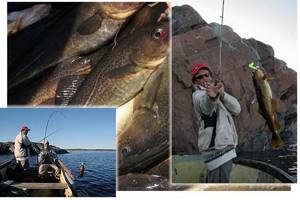
Offered by many travel companies, fishing on the White Sea in summer in coastal areas includes a full range of services. Tourists are offered everything: from accommodation and meals to the services of experienced rangers-guides from local residents. They not only know every surrounding fishing spot very well, but also guarantee an exciting and unforgettable underwater hunt.
Tackle for catching flounder
Among most fishermen, both amateurs and professionals, cod fishing in the White Sea is of interest. Regardless of the season and weather conditions, the bite is successful. The main thing is to know the primary secrets regarding the habitat of such fish, the options for the gear used and fishing tactics.
Cod fishing on the White Sea
Fishing on the White Sea differs from fishing in other seas or reservoirs, this is due to climatic conditions.
The main features of fishing on the White Sea:
- Cold water, even in summer.
- The maximum water surface temperature in the hottest month does not exceed 18 degrees Celsius.
- Complex bottom topography, as well as highly pronounced ebbs and flows.
- Frequent changes in wind direction.
- Mostly cold gusts of wind are observed, often stormy.
- The average wave height is 2-3 meters.
- The need to use several types of bait, including artificial ones.
- The probability of catching a large cod is minimal.
- The weight of such an individual varies from 750 to 950 grams.
- Possibility of successful biting around the clock and even in bad weather conditions.
The length of cod in the White Sea rarely reaches more than 50-60 centimeters, with the smallest size observed in the summer.
For an untrained fisherman, fishing is quite difficult the first few times, so it is better to take an experienced person with you.
Where to look for cod in the White Sea?
Due to the relief features of the White Sea, as well as its depth differences, the distribution of cod in different areas is not the same.
You need to look for such fish depending on several factors:
- Season: in winter and until the end of spring - mainly at depth or in straits, and also where there is movement of warm currents.
- all summer and early September - it is better to look for nearby coasts;
- closer to mid-autumn and before the beginning of winter - mainly near rocks or in crevices.
- if fishing is done from the shore, then you need to choose places near the rocks;
- depths from 5 to 10 meters are most successful for fishing in the warm season;
Interesting fact: June and July are the months in which the greatest bite is observed, but the fish caught are on average about 30 centimeters long.
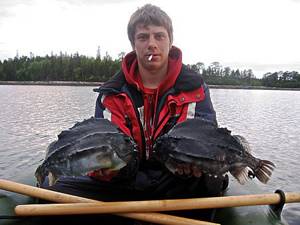
Among experienced fishermen, it is believed that the most successful place is an area rising 2-3 meters above the sea surface.
At any time of the year, you should not try to look for cod along sandy beaches or in bays with a large predominance of foam; the individual especially does not like these areas of the sea. You can try your luck on Kandalaksha Bay - this is a favorite place for many fishermen.
When to catch cod on the White Sea?
On the White Sea, cod fishing is guaranteed in any season, each has key features and distinctive points:
- Fishing in winter and spring: the possibility of biting the heaviest individuals;
- most often you come across a fish of about 900 grams, this is considered large in size for the White Sea;
- maximum predominance of cod at depth or in underwater crevices;
- It bites best on a combination of organic and artificial baits.
- cod is small in size, approximately 40 centimeters and weighing 700-800 grams;
Knowledgeable fishermen claim that on the White Sea the most fruitful periods for biting are as follows:
- from late April to mid-May - especially near the coast;
- from the first days of June to mid-October - at a distance of 150-200 meters from the shore.
Interesting fact: the bite is lowest during the period when there is a rise in cold waters from the depths, so it is advisable to refuse fishing on these days.
Fishing from a boat or from the shore?
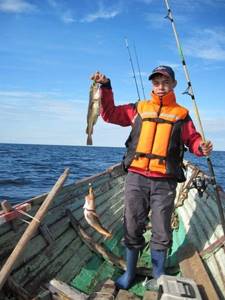
Fishing can be done quite successfully both from the shore and from a boat. Basically, experienced fishermen prefer to fish on motor boats; this makes it possible, in case of low bite in one area, to move to another area.
On the White Sea, fishing from boats has some characteristic features:
- it is necessary to move away from the shore by more than 200 meters, this allows you to not depend on the tides;
- it is required to use fishing lines exclusively with a diameter of 0.5-0.7 millimeters;
- you need to give preference to fishing gear and choose hooks made of brass;
- with the arrival of cold weather, be sure to move closer to the stone ridges, and in warm weather, choose an area near the rocks;
- move to a depth of at least 10-12 meters and where there is a strong current.
Many fishermen note that fishing for cod from the shore will bring more expected results, especially from the end of May to mid-August, the main thing is:
- fish during high tide;
- change bait as often as possible;
- cast with several fishing rods, preferably long in size;
- be located next to rocks;
- choose the time for fishing from 6-7 am until noon.
In early May, and if the spring is warm, then from the end of April it is better to fish from the shore, since at this time the cod approaches the very coast.
Tackle for cod fishing on the White Sea
Successful fishing directly depends on correctly selected gear. In general, it is possible to fish with various options of float rods, spinning rods and other things.
Because
this fish leads an exclusively bottom-dwelling lifestyle
Accordingly, flounder fishing is carried out using bottom gear. For this, powerful rods are best suited - carp or feeder rods, with a length of at least 3.9 meters, and preferably even longer.
The best choice would be a special saltwater fishing rod that has the necessary power and a protective coating against corrosive sea salt. Test rods should be chosen from 150 grams and above, since heavy weights should be used - which stick well to the seabed.
The rod should be equipped with a powerful spinning reel with a spool size of at least 5000, which can accommodate at least 150–200 meters of fishing line with a diameter of 0.35–0.4 mm. It is better to use monofilament fishing line; using a cord is not advisable, as it can rub against the rocky seabed.
It is better to prepare gear for catching flounder in advance, since on most fishing trips there is a loss of sinkers or hooks, so it is advisable to have a certain supply of them, which is wound on the reel.
Everything you need can be purchased in the store, but equipment for catching flounder made by yourself is of great value.
To make gear you will need:
- the required number of 1.5 meter pieces of fishing line of the same diameter as the main fishing line;
- the required number of hooks No. 6–8 or 10, depending on the size of the intended prey. Hooks must have a long shank, since flounder swallows bait deeply and in order to get a small hook, it is sometimes necessary to cut the fish;
- fishing line for leashes is taken with a diameter of 0.2-0.25 mm;
- flounder really loves colored baits, so you need to have a pea-sized supply of red and green beads;
- a set of weights from 70–80 to 200 grams. Different fishing conditions may require different weights of different designs. The larger the wave or the sea current, the mass of the cargo should accordingly be greater;
- To quickly change gear, it is best to use powerful carabiners, which can be used to fasten both the tackle and the sinker.
To make the equipment, leashes 10–15 cm long are prepared, to which hooks are tied, and beads are placed on top of the hooks - one red and one green. The beads are fixed with a stopper. Leashes in the amount of 3 pieces are tied onto the rig at intervals of 20-30 cm, and carabiners are tied at the ends: one for the load, and the other for attaching to the main fishing line.
Then the finished product can be carefully wound on the reel and the next one can be made. In order to be fully equipped, it is better to make at least 10 gear, but as the planned scale of future fishing increases, their number will naturally increase proportionally. We also suggest that you familiarize yourself with this video about equipment for catching flounder.
Are you interested in catching porpoise? Our article will tell you and show you more about this. Here you will learn how to fish on the famous path.
Flounder is probably the most exotic fish in our seas - it is flat and both of its eyes are located on one side of the body. All this happened because these fish are notorious couch potatoes, lying at the bottom for hours, buried in the sand.
Flounder is also found in the Black Sea, but fishing there is prohibited. But several smaller species of flounder, which come to spawn on the shores of the Pacific Ocean, White, Barents and North Seas, are commercial fish.
Flounder is perhaps the most exotic fish in our seas - it is flat, and both of its eyes are located on one side of the body. All this happened because these fish are known couch potatoes, lying at the bottom for hours, buried in the sand.
Flounder is also found in the Black Sea, but fishing there is prohibited. But several smaller species of flounder, which come to spawn on the shores of the Pacific Ocean, White, Barents and North Seas, are commercial fish.
Since mid-April, this fish can be seen in the sandy bays of Vladivostok and Kaliningrad - it comes from deeper and colder areas. This fish bites where it lives, in those areas where the bottom is muddy and sandy.
Fishing from the shore is a futile activity - flounder practically does not come close to it. For all types of flounder, the same tackle is used - a bottom fishing rod with a blind sinker at the end and several liners of different lengths.
When moving along the bottom, the liners are extended and the hooks are located at an equal distance from the bottom. During fishing, the nozzle should be 2-3 cm from the ground surface.
This is due to the nature of the flounder bite - there is practically none. Having swallowed the bait, the fish continues to lie on the bottom and you can feel that the bait has been eaten only if the fish begins to move.
The bait used is mussels and other mollusks that stick to algae or structures located in sea water, insect larvae, shrimp, pieces of small fish, and various spinners of intricate shapes and bright colors.
The choice of bait is best done locally. The optimal hook size is No. 4 according to European numbering; it is quite sufficient, since the size of the flounder’s mouth is small.
It is better to catch flounder from a boat or on board any other small vessel. In this case, it is necessary to place it on one anchor so that the ship moves slowly in an arc.
Sloth flounder do not chase bait, and this movement increases the chances of catching more fish. However, it is also caught well from long piers that go far into the sea.
The optimal time for catching flounder is before dawn; after the sun has risen, there is a short break, after which the bite resumes until 12 noon. Evening dawn can also be successful, but especially large specimens are caught at night.
The long-awaited summer has arrived, it’s time to go on vacation to the Black Sea. Sea fishing is very popular - both among vacationers and local residents.
In order not to just sit with a fishing rod on the shore, but to actually catch fish, use the most effective methods: spinning fishing with wobblers and jigs, as well as a tyrant.
- — spinning;
- — fishing line (braid);
- — carabiner;
- - sinker;
- - leashes;
- — chrome hooks;
- - bait.
For cod
Many people go fishing in the White Sea precisely because of this fish. The cod here is noticeably different from the usual Atlantic cod in its size. Its weight, as a rule, is one and a half or two times less than its ocean sister. The length of the cod that lives in the White Sea is no more than sixty centimeters. But even such, to put it mildly, non-trophy specimens do not pamper fishermen. The largest individuals can only be hooked in the deep Kandalaksha Bay. When fishing in the White Sea for the largest cod, according to experienced hunters, you need to go there and fish near the steep cliffs that go into the water. But small specimens are caught well both in shallow water and in places where the bottom is almost covered with stones.
Local residents distinguish between small summer cod, which the Pomors call “pertui”, and also larger winter cod, which appears on the coast only in late August - early September. The largest ones are caught by fishermen in Kandalaksha Bay, the deepest bay of the White Sea. In the open sea, it is better to catch cod near rock ridges covered with bottom kelp or seaweed. Typically, such banks that rise sharply above the rest of the relief dry out in their upper parts after low tide. North Karelia is famous for such places, which locals call korgs or baklysh. The White Sea, where fishing, according to many professionals, is simply unique, attracts with its surrounding taiga nature and a truly unforgettable vacation with a fishing rod in hand.
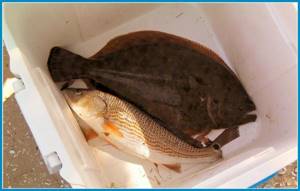
Catching cod in the Barents Sea - Fishing - Okhotniki.ru
For sea fishing, you should prepare strong and reliable cod fishing gear. Most anglers choose metal spinning rods or fiberglass rods.
The length of the spinning rod can be from 1.8 to 2.4 m. Monofilament with a diameter of 0.6-0.7 mm is used for fishing line.
Braided fishing lines 0.25-0.4 mm are becoming increasingly popular among anglers, as they make the fishing line more sensitive to bites and hooks.
When deciding which tackle to choose for cod, the angler should pay special attention to the reel. It is advisable that it be a baitcasting reel for sea fishing that does not rust from salt water. The reel plays the role of a winch; it will be used to catch cod. Therefore, it must be strong and reliable, capable of holding 150 m of braid.
To take the caught cod onto the ship, you will need a sharp hook. It is easy for them to hook a cod and then remove it from the prey. It is advisable that the hook has a long handle, this will make it more convenient to pick up the fish further from the edge of the boat. A landing net will not work, as its mesh gets caught on the hooks from the bait garters, and then it takes a lot of time to remove them.
Among most fishermen, both amateurs and professionals, cod fishing in the White Sea is of interest. Regardless of the season and weather conditions, the bite is successful. The main thing is to know the primary secrets regarding the habitat of such fish, the options for the gear used and fishing tactics.
Cod fishing on the White Sea
Fishing on the White Sea differs from fishing in other seas or reservoirs, this is due to climatic conditions.
The main features of fishing on the White Sea:
- Cold water, even in summer.
- The maximum water surface temperature in the hottest month does not exceed 18 degrees Celsius.
- Complex bottom topography, as well as highly pronounced ebbs and flows.
- Frequent changes in wind direction.
- Mostly cold gusts of wind are observed, often stormy.
- The average wave height is 2-3 meters.
- The need to use several types of bait, including artificial ones.
- The probability of catching a large cod is minimal.
- The weight of such an individual varies from 750 to 950 grams.
- Possibility of successful biting around the clock and even in bad weather conditions.
The length of cod in the White Sea rarely reaches more than 50-60 centimeters, with the smallest size observed in the summer.
And here's what you need to know: Fishing for bream in summer Place baits Summer fishing for bream
For an untrained fisherman, fishing is quite difficult the first few times, so it is better to take an experienced person with you.
Where to look for cod in the White Sea?
Due to the relief features of the White Sea, as well as its depth differences, the distribution of cod in different areas is not the same.
You need to look for such fish depending on several factors:
- Season: in winter and until the end of spring - mainly at depth or in straits, and also where there is movement of warm currents.
- all summer and early September - it is better to look for nearby coasts;
- closer to mid-autumn and before the beginning of winter - mainly near rocks or in crevices.
- if fishing is done from the shore, then you need to choose places near the rocks;
- depths from 5 to 10 meters are most successful for fishing in the warm season;
Interesting fact: June and July are the months in which the greatest bite is observed, but the fish caught are on average about 30 centimeters long.
Among experienced fishermen, it is believed that the most successful place is an area rising 2-3 meters above the sea surface.
At any time of the year, you should not try to look for cod along sandy beaches or in bays with a large predominance of foam; the individual especially does not like these areas of the sea. You can try your luck on Kandalaksha Bay - this is a favorite place for many fishermen.
When to catch cod on the White Sea?
On the White Sea, cod fishing is guaranteed in any season, each has key features and distinctive points:
- Fishing in winter and spring: the possibility of biting the heaviest individuals;
- most often you come across a fish of about 900 grams, this is considered large in size for the White Sea;
- maximum predominance of cod at depth or in underwater crevices;
- It bites best on a combination of organic and artificial baits.
- cod is small in size, approximately 40 centimeters and weighing 700-800 grams;
Knowledgeable fishermen claim that on the White Sea the most fruitful periods for biting are as follows:
- from late April to mid-May - especially near the coast;
- from the first days of June to mid-October - at a distance of 150-200 meters from the shore.
Interesting fact: the bite is lowest during the period when there is a rise in cold waters from the depths, so it is advisable to refuse fishing on these days.
Fishing from a boat or from the shore?
Fishing can be done quite successfully both from the shore and from a boat. Basically, experienced fishermen prefer to fish on motor boats; this makes it possible, in case of low bite in one area, to move to another area.
On the White Sea, fishing from boats has some characteristic features:
- it is necessary to move away from the shore by more than 200 meters, this allows you to not depend on the tides;
- it is required to use fishing lines exclusively with a diameter of 0.5-0.7 millimeters;
- you need to give preference to fishing gear and choose hooks made of brass;
- with the arrival of cold weather, be sure to move closer to the stone ridges, and in warm weather, choose an area near the rocks;
- move to a depth of at least 10-12 meters and where there is a strong current.
Many fishermen note that fishing for cod from the shore will bring more expected results, especially from the end of May to mid-August, the main thing is:
- fish during high tide;
- change bait as often as possible;
- cast with several fishing rods, preferably long in size;
- be located next to rocks;
- choose the time for fishing from 6-7 am until noon.
In early May, and if the spring is warm, then from the end of April it is better to fish from the shore, since at this time the cod approaches the very coast.
Tackle for cod fishing on the White Sea
Successful fishing directly depends on correctly selected gear. In general, it is possible to fish with various options of float rods, spinning rods and other things.
And here's what you need to know: Finding fishing spots in different bodies of water
In the distant and cold Barents Sea, which is an integral part of the Arctic Ocean, lives a fish called cod. Different fishermen treat it differently.
Some consider this fish to be an object of industrial fishing. Some people appreciate it for its excellent taste. Someone makes money from these fish by catching them with sporting equipment.
Where and how to catch cod
Be that as it may, cod fishing was, is and remains very interesting and attractive not only for residents of the Murmansk and Arkhangelsk regions.
You can catch this fish from the shore, from coastal rocks, from piers and various marine engineering structures, from boats, boats and large vessels.
|
| Photo: Gennady Shelyag. |
For coastal fishing, any acceptable spinning gear is usually used. When fishing this way, natural baits and small spinning lures are often used.
For fishing from boats, boats and various vessels, more specific gear is used.
Sea spinning
Usually these are spinning rods up to 2.5 m long, 80-120 lb test, marine multipliers that can hold 300 meters of braid with a diameter of 0.4 mm.
The equipment for cod consists of a punda or jig weighing 0.4-1 kg, equipped with single or triple hooks. Above the main cargo bait there are one, two or three hooks on short leashes. All hooks on the rig are used in combination with various silicone baits.
The will of your imagination
We can say that equipment for cod fishing allows for a lot of arbitrariness in their manufacture. Here you can give free rein to your fantasies.
Whitefish
This underwater inhabitant is no less an honorable trophy than cod. Whitefish are found in coastal waters in the White Sea. It feeds in numerous small places in the straits and bays, where it feeds on various bottom animals - sea worms, mussels, amphipods. In August, whitefish rush to rivers to spawn. Most of them lay eggs only two or three times in their lives.
Whitefish also winter in rivers or in desalinated areas of the sea near the mouth. Fishermen fish for this fish, as a rule, during its spawning migrations, just like salmon, pink salmon or brown trout - using spinning rods or nets. Whitefish are sometimes caught in the sea while fishing for herring or smelt. In addition to the migratory species, that is, migrating to the river from the White Sea and back, there are lake and river forms that never leave fresh water. The meat of this fish is highly valued for its amazing taste, but whitefish is especially good when salted or smoked.
Catfish
People most often go to Kandalaksha Bay for fishing in the White Sea for this fish. This is where one of the varieties of Atlantic catfish lives, the length of which can reach eighty-five centimeters. For fishermen, it is like a trophy, which is in no way inferior in value to cod. Catfish has tasty and tender meat, and in July you can even feast on its caviar, which tastes no worse than salmon.
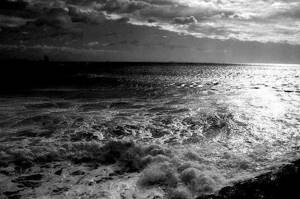
The diet of this fish is quite varied. It includes crabs and shellfish, starfish and shrimp, and sometimes catfish does not disdain small fish. This fish has excellently developed chewing and conical teeth, which easily grind and crush the fairly durable skeletons of a wide variety of echinoderms and crustaceans.
Catfish are fished with bottom gear. Starting from May, it can be caught even at fairly shallow depths not far from the shore - in coastal waters. As for the rest of the time, when it goes deeper, it becomes a rather difficult prey. To catch it, you need to use only steel or Kevlar leashes, since it easily grinds everything else with its teeth.
Cod: description and hunting
Cod is considered one of the popular fish in the White Sea. Cod lives and spawns mainly in Kandalaksha Bay, where there is salt water. Unlike the Atlantic one, this species is smaller. Its length is approximately 60 cm, but mostly smaller individuals are found. In summer and early autumn, cod lives close to the shore. Larger specimens should be looked for near rocks that go into the sea. Small specimens can be caught near the rocky shore in shallow water.
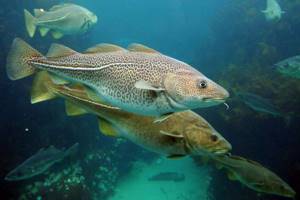
Flounder
There are fish that are of particular interest to specialists studying the White Sea. Flounder is one of them. Five species of this fish are found in the White Sea. Three species - river, polar and ruff - belong to local forms, so they are found in almost all zones of the reservoir. The other two species - sea flounder and ruffed flounder - swim to the White Sea from the Barents Sea for fattening. This happens in the summer months. Local residents recommend catching flounder with float rods or tyrants with small hooks. It is better to use Nereis worms as bait, which can easily be found in the sandbanks at low tide.
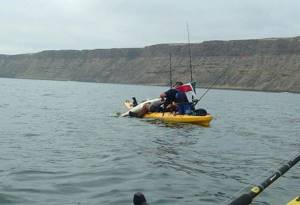
Fishing on the Karelian coast
This is not only the most beautiful, but also the most fishy place in the White Sea. It is one of the most tranquil and beautiful places in Russia, where fish abound. Sea hunting enthusiasts from the Norwegian fjords gradually began to come here. However, fishing on the Karelian coast of the White Sea has gained the greatest popularity for Russians with average incomes. This coast is literally replete with tourist centers, which are intended primarily for economy-class accommodation in order to engage in your favorite hobby, which is fishing, without special expenses. In Belomorsk on the White Sea, smelt and navaga are well caught.
In general, fishing and relaxation on the Karelian coast of this bay of the Arctic Ocean will delight not only professionals. Many people come here to combine a family vacation with their favorite pastime. It is believed that nothing brings people closer together than shared excitement and, of course, the anticipation of a bite. At the same time, everyone enjoys swimming in the sea in the summer months: both children and parents.
Most of all, cod fishing lovers come here. In order to return with a good catch, in these places you need to have at hand a boat or motorboat with a powerful motor, a shovel, an anchor, fifty to seventy meters of rope, tackle, a map, GPS, and an echo sounder. The most convenient place in terms of transport access on the North Karelian coast on the White Sea is Chupa. Here you have the opportunity to leave your car in a guarded parking lot, rent a boat, motorboat or even a yacht, and hire a huntsman guide who can show you the best fishing spots for successful fishing. It must be borne in mind that to such areas you need to sail by boat along the Chupinskaya Bay, located in Kandalaksha Bay, thirty or forty kilometers deep into the White Sea. Those interested can book a fishing tour at the local yacht club, and those who are confident in their abilities and have all the necessary equipment have the opportunity to go spearfishing on their own.
Fishing bases
There are several fishing bases near the White Sea. They offer a certain range of services to significantly increase the comfort of fishing. The price for services is relatively low. The only thing that is quite expensive is renting a vessel to go to sea. This is due to the fact that in order to go out into the open sea, the craft must be large enough to withstand the shock of the waves.
Sonostrov
Sonostrov is a base on the seashore. Here you can rent the necessary equipment and watercraft. Nearby there are lakes and rivers into which fish enter during spawning in search of food.
On the territory there are:
- houses for living;
- bath;
- dining room and many other facilities.
The tourist base is located at a distance of 50 kilometers from the nearest settlement. There are small houses on site that can be rented for vacation.
Gridino
Gridino on the White Sea is a tourist base dedicated to hunting and fishing. Fishing is possible upon receipt of a license, the cost of which is 1,000 rubles per person per day.
Around the base there are several rivers and lakes that flow into the sea. It is in river and lake waters that fish often enter to feed. In this case, fishing can be done from the shore, and not from a rented boat. This point significantly reduces costs.
The White Sea, despite the cold waters, allows you to have a good time and catch a variety of fish. At the same time, the gear used, the choice of fishing location - everything is quite universal, since sea fish is unpretentious and can be caught with many things. It is only important to consider whether the hunt is for predatory or ordinary fish.
Tackle
Most often, experienced fishermen use onboard short spinning rods and a Neva reel - “Nevka” - as equipment. In principle, the improved donka, which is used for fishing using the “finger” technology, “works well” here. The fishing technique is as follows: the tackle with bait goes down to the very bottom, then several blows are made one after another, after which it rises thirty to fifty centimeters. Fishing should continue with short but intense twitches. Using this technology, they primarily catch cod, a prominent and treasured local trophy. The bite of this fish is sharp. In small individuals - one or two twitches, and then a blow. Whereas large cod starts immediately with a sharp bite. At the same time, after hooking, the fisherman must not give up slack, especially when fishing with a finger or with an onboard spinning rod.
After a few bites, be sure to check for bait, as cod have an amazing ability to pull it off. To reduce the number of hooks and subsequent loss of the spoon during bottom fishing, single hooks are most often used. But an onboard spinning rod, which allows you to make small casts, is excellent for finding fish.
Cod also bites well on various jigs with silicone fish. Using the technique of “shelling” the fishing area with long casts, you can achieve very good results. However, this method of fishing has one drawback: a long rod. This makes it impossible for more than two anglers to fit in the boat.

